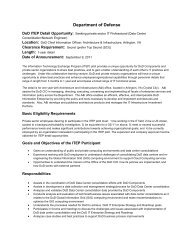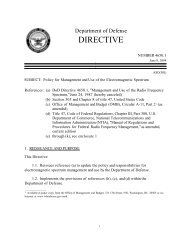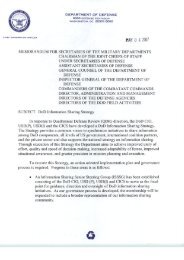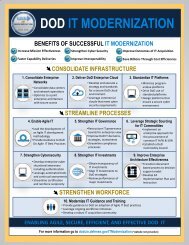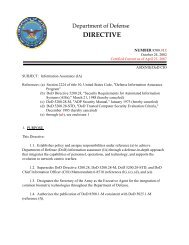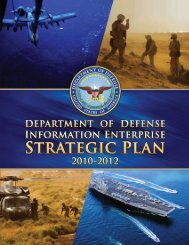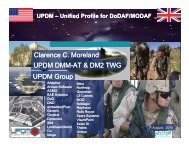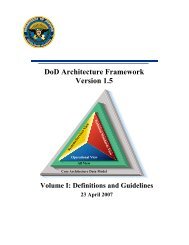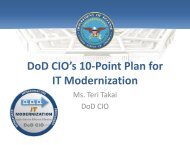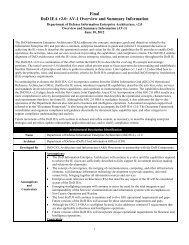DoD IEA v2.0 - Chief Information Officer
DoD IEA v2.0 - Chief Information Officer
DoD IEA v2.0 - Chief Information Officer
You also want an ePaper? Increase the reach of your titles
YUMPU automatically turns print PDFs into web optimized ePapers that Google loves.
<strong>DoD</strong> <strong>Information</strong> Enterprise Architecture Version 2.0The total set of IE capabilities is meant to represent everything that must be done or provided in theIE to meet operator needs. Complete IE capability descriptions should also include a set of measuresfor use in determining when the capability has been achieved; such measures are not currentlyincluded in this version of the <strong>DoD</strong> <strong>IEA</strong>, but are planned for a future release.More detailed descriptions of the IE capabilities can be found in Section 5 of Volume II.3.3 Operational Activities, Services, and RulesIE capabilities are described in the <strong>DoD</strong> <strong>IEA</strong> in terms of the activities that need to be performed toenable the capability, the services that would ideally be implemented to perform those activities, andthe rules that govern how the services should operate and how the activities should be performed toachieve the desired results.3.3.1 Operational Activities in the <strong>DoD</strong> <strong>IEA</strong> <strong>v2.0</strong>The <strong>DoD</strong> <strong>IEA</strong> <strong>v2.0</strong> activities and their definitions are based on separate, but related, activityhierarchies taken from the GIG 2.0 ORA v1.5 and <strong>DoD</strong> <strong>IEA</strong> v1.2. Activities contained in these twoexisting documents were aligned, normalized, and then combined to form the <strong>DoD</strong> <strong>IEA</strong> <strong>v2.0</strong> activityhierarchy. A mapping of GIG 2.0 ORA and <strong>DoD</strong> <strong>IEA</strong> v1.2 activities with <strong>DoD</strong> <strong>IEA</strong> <strong>v2.0</strong> activities toassist users in transitioning to the <strong>DoD</strong> <strong>IEA</strong> <strong>v2.0</strong> can be found in Appendix F of Volume II. Theactivities are decomposed using the following main activities:• Manage and Oversee the IE – This activity governs the development and implementation ofthe IE. It establishes and uses those structures and processes required to provide effective,high-level management and oversight of the components of the IE and its operations. Theactivity develops and enforces the required vision, strategy, and guidance to direct the IE so itmeets requirements and applicable law, regulation, and policy (LRP), while at the same timedelivering the capabilities necessary to fully enable net-centric warfighting, business, anddefense intelligence operations for successful mission accomplishment.• Protect and Secure the IE – This activity develops and implements processes andmechanisms required to guard critical data, capabilities, the IT infrastructure, and dataexchanges within the IE, while providing authentication and non-repudiation of informationand transactions to enable assurance and trust. It provides the ability to control user access todata and services, determine vulnerabilities, and prevent the exploitation of thesevulnerabilities by both external and internal threats. The activity enables the monitoring of IEoperations, recognition and assessment of security-related incidents, and selection andexecution of appropriate responses.• Provide IE Infrastructure – This activity supplies the enterprise-level communications andcomputing capabilities required to enable net-centric operations and the Enterprise-wideservices required by all users. It provides basic IT elements/components which arefoundational to the <strong>DoD</strong> IE and which enable it to fully support assured information sharingacross the Enterprise and with mission partners.• Control and Operate the IE – This activity implements capabilities required to provideintegrated NetOps in order to enable information access by any user across network andsecurity domains. It includes processes and mechanisms for Enterprise Management, ContentManagement (which includes Records Management), and Network Defense. The activity13




